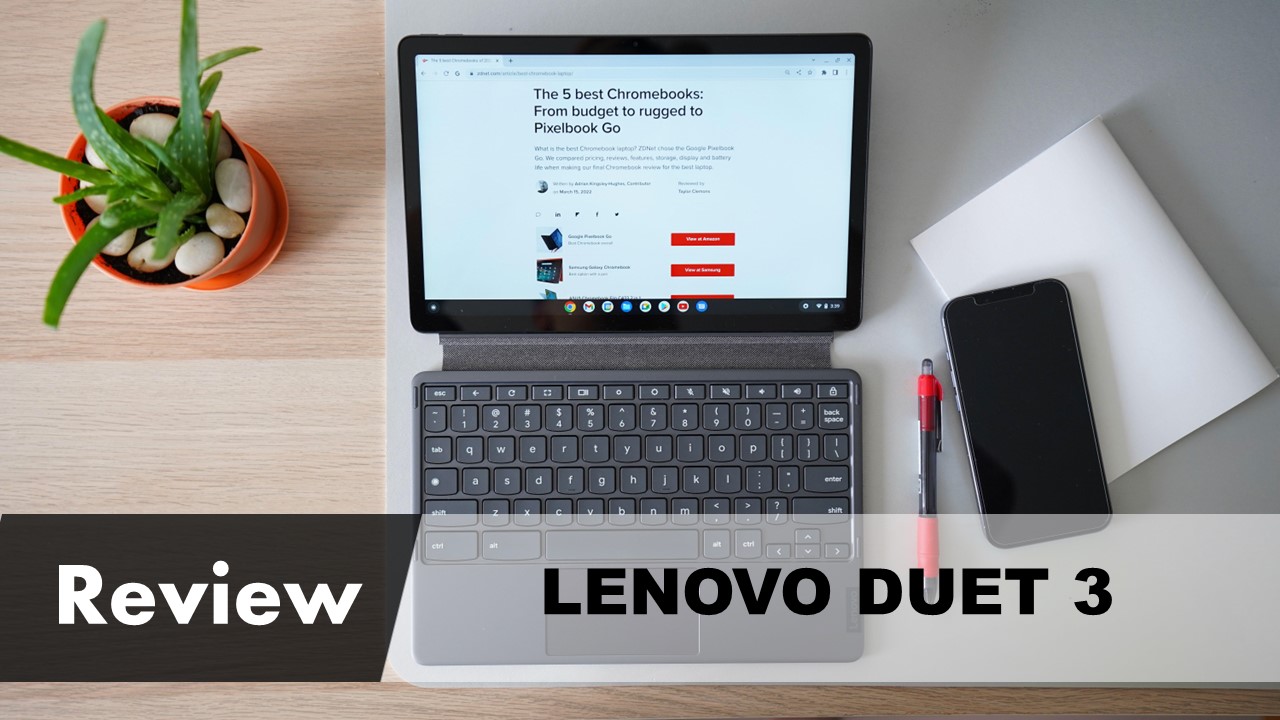The Lenovo Duet 3 is making waves in the tech world, and it’s easy to see why. This 2-in-1 Chromebook is designed to meet the needs of users seeking versatility without breaking the bank. From its sleek design to its functional features, the Duet 3 promises to be a reliable companion for both work and play. But does it deliver? Let’s dive into the details.
Please follow us on Twitter and Facebook.
TheTechBasic Verdict
Lenovo’s Duet 3 steps up from the original Duet with a bigger, brighter display and more power under the hood. Though it comes with a higher price tag and a bit shorter battery life, it still hits that perfect balance: an affordable, high-performing Chrome tablet with an included keyboard that transforms it into a versatile 2-in-1 device.
Pros:
- Bright, sharp display
- Over 10 hours of battery life
- Decent included keyboard cover
- Impressively loud for a Chrome tablet
Cons:
- No headphone jack
- Underwhelming cameras
- Keyboard cover can be uncomfortable for long typing sessions
Technical specifications
| Component | Specification |
| Price | $359 |
| CPU | Qualcomm Snapdragon 7c Gen 2 |
| Display | 11 inches, 2000 x 1200 resolution |
| Memory | 4 Gigabyte |
| Storage | 64 GB – 128 GB |
| Camera | 8 Megapixel (rear), 5 Megapixel (front) |
| Size | 6.48 x 10.16 x 0.31 inches |
| Weight | 1.2 lbs (tablet only), 2.1 lbs (tablet + cover) |
| Ports | 2 USB-C 3.2 Gen1 |
| Connectivity | 802.11 a/b/g/n/ac, Bluetooth 5.1 |
The Lenovo IdeaPad Duet 3, starting at $359, has arrived and offers plenty of reasons for excitement. This model is a larger, pricier upgrade to the 2020 Lenovo Chromebook Duet, a budget-friendly and surprisingly capable Chrome tablet. The original Duet was praised for its impressive battery life, solid performance, and decent included keyboard cover, all at around $250 or less with a Lenovo coupon.
The new Lenovo Duet 3 costs a bit more but offers a larger, brighter display, additional ports, and the upgraded power of a Qualcomm Snapdragon 7c Gen 2 chip. After a few weeks of use, I can confidently say that this model is a worthy successor despite a few minor flaws. It’s not only one of the best Chromebooks for kids but also stands out as one of the top-budget laptops overall. Read on to discover why.
Availability and price of Lenovo Duet 3
In the U.S., you can snag Lenovo Duet 3 for as low as $270 from Lenovo, which includes a model with 4GB of RAM and 64GB of storage.
Read Also: Lenovo Return Policy – Detailed Guideline and Steps
Our review unit has a special configuration of 8GB of RAM and 64GB of storage, as it’s an early prerelease model sent for review. This specific setup with maximum RAM and minimum storage isn’t available for purchase, but otherwise, it seems identical to the retail version.
Design of Lenovo Duet 3
The Lenovo Duet 3 closely resembles Lenovo’s original Duet Chromebook from 2020, but it’s a bit larger with an 11-inch 2K screen (2,000 x 1,200 pixels) encased in a sleek black aluminum body. Measuring 10.16 x 6.48 x 0.31 inches and weighing about 1.14 pounds, the Duet 3 is almost as light and thin as the base iPad 2021 (0.29 inches, 1.09 pounds). It feels both sturdy and lightweight, making it easy to carry around all day.

Lenovo kept the two-piece design with a detachable keyboard and cover that have a thick-woven cloth texture, which feels nice to the touch. Like its predecessor, the Duet 3’s keyboard and back cover attach separately but magnetically snap into place. The keyboard cover feels solid for typing, and on our review unit, the magnets are strong enough to make the keyboard and tablet snap together with impressive force when they’re close enough.
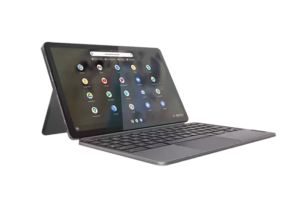
The rear cover also attaches quickly and easily, featuring a fold-out lower half that acts as a kickstand. However, it can be a bit tricky to get a finger under the flap to extend it.
Display of Lenovo Duet 3
The Lenovo Duet 3 boasts a larger, brighter screen with a higher resolution than the original Duet. Lenovo claims it can reach up to 410 nits of brightness, but our lab tests showed our review unit surpassed this, reaching an average brightness of 444.4 nits and peaking at 456 nits in the center. This is an improvement over the original Duet’s 362 nits and outshines other Android tablets like the Lenovo Yoga Tab 13 (395 nits), though it falls short of the iPad 2021’s 471 nits.
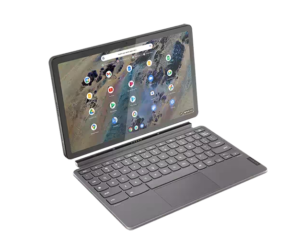
Regarding color accuracy, the Duet 3’s display covers 109.4% of the sRGB color gamut and 77.8% of the DCI-P3 color gamut. While these figures are particularly relevant for serious photo and video editors, they indicate that the Duet 3 is on par with the original Duet (104% sRGB) and the 2021 iPad (106.3% sRGB).
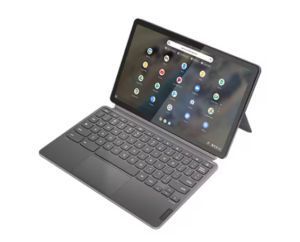
To my eyes, the Duet 3’s display is bright and colorful. Although it may not be as stunning or vibrant as top OLED displays on devices like the Samsung Galaxy Tab S8 Ultra, it’s more than adequate for a $400 Chrome tablet. Playing games, Watching YouTube videos, and even viewing horror movies like The Conjuring on the 2K display was a pleasant involvement.
Ports of Lenovo Duet 3
Lenovo has upgraded the port options on the Duet 3, now featuring a pair of USB-C 3.2 Gen 1 ports—one on each side of the tablet in landscape mode.
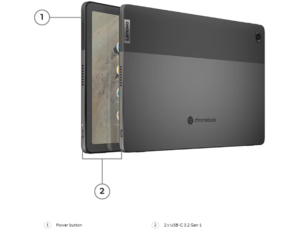
This is an improvement over the original Duet, which only had a single USB-C port. Since the Duet 3 still charges via USB-C, you now have the flexibility to choose which side of the tablet to connect for charging. Additionally, either port can be used to connect an external display, making it convenient to set up the Lenovo Duet 3 for enhanced productivity at a desk.
However, it remains a somewhat limited device that may require adapters and cable swapping for a variety of accessories.
Unfortunately, the Lenovo Duet 3 continues the trend of omitting a headphone jack, a feature sorely missed from the original Duet. These tablets are designed to serve multiple computing purposes, and the original Duet gained popularity among parents during the COVID-19 pandemic as an affordable Chromebook for remote learning. It’s disappointing that both the Duet and Duet 3 lack the option to plug in inexpensive earbuds. As it stands, users will need to invest in wireless earbuds or headphones for private listening or Zoom calls on the Duet.
Performance of Lenovo Duet 3
Our prerelease review unit of the Duet 3 is equipped with a Qualcomm Snapdragon 7c Gen 2 chip and 8GB of RAM, providing ample power for multitasking between web browsing, work, and light gaming.
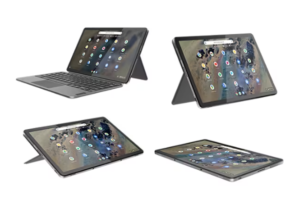
During my testing period with the Lenovo Duet 3, I found it to be quite responsive for a Chromebook, experiencing minimal slowdown when launching and switching between applications. I managed to open 15 tabs in Chrome, stream music, watch videos on the Amazon Prime Video app, and play games downloaded from the Google Play Store without encountering significant performance issues.
In the Geekbench 5.4 multi-core CPU benchmark, the Lenovo Duet 3 achieved a score of 1,742. While this is lower compared to most laptops, it’s important to note that the Lenovo Duet 3 runs on a Snapdragon SoC designed for Chromebooks, not on the latest Intel or AMD CPUs found in more expensive ultraportables. When compared to its predecessor and similarly equipped tablets, the Duet 3 performs admirably.
For instance, the unique Lenovo Duet we studied 4 years ago did not undergo Geekbench 5 testing, but it would likely be outpaced by the new Lenovo Duet 3. In comparison, the Microsoft Surface Go 3 (Intel Core i3-10100Y, 8GB RAM) scored lower at 1,561, as did its predecessor, the Surface Go 2 (Core m3-8100Y CPU, 8GB RAM), with a score of 1,627. However, more powerful and pricier tablets such as the Microsoft Surface Pro 8 (Intel i7-1185G7, 16GB RAM) and Apple iPad Air 5 (M1 chip, 8GB RAM) significantly surpassed the Lenovo Duet 3 with scores of 5,357 and 7,161, respectively.
We also evaluated the Lenovo Duet 3 using the JetStream 2 benchmarking suite to assess its performance with web apps, where it achieved a score of 62.7. While respectable, this places the Lenovo Duet 3 slightly behind more expensive tablets like the Samsung Galaxy Tab S8 (121.3) and the iPad Air 5 (208.2).
Audio of Lenovo Duet 3
The Lenovo Duet 3 is equipped with a pair of 1W speakers that deliver respectable volume, making it surprisingly loud for a Chrome tablet. However, the sound lacks bass and depth.
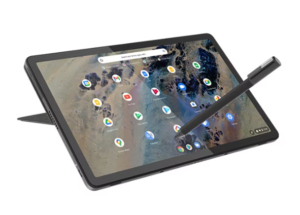
On the flip side, it can also be remarkably quiet. In my mid-30s, I found our Duet 3 review unit almost inaudible when set below about 20% of the maximum volume. While this isn’t usually a major issue, it does feel odd to have to increase the volume several notches above the lowest setting just to hear anything.
Keyboard and Touchpad of Lenovo Duet 3
The included detachable keyboard cover is surprisingly good, especially considering it’s included at no extra cost. The keys feel satisfying to type on, despite their shallow travel. However, the keyboard itself may feel cramped and uncomfortable for larger hands, which is typical for an 11-inch tablet.
Despite its size, the Lenovo Duet 3’s keyboard is sufficient for tasks like typing emails, blog posts, and even term papers, making it a reliable productivity tool when needed. It’s worth noting that the detachable keyboard is not very thick or sturdy, so it’s best used on a solid surface like a desk rather than on your lap for extended typing sessions.
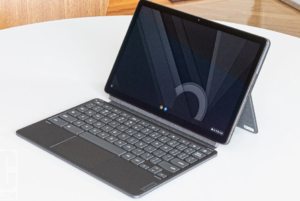
Overall, the quality and inclusion of this keyboard contribute to the Lenovo Duet 3’s excellent value proposition.
The touchpad on the keyboard is equally functional and convenient, particularly useful when avoiding screen smudges or when precision is needed, such as adjusting volume without touching the display with messy fingers.
Camera of Lenovo Duet 3
The front-facing 5MP camera on the Duet 3 may not give you the most flattering image. During video calls using Google Meet, I noticed that the camera tended to make me appear even more washed out and pale than usual.
When testing the rear-facing 8MP camera, I found its performance to be equally underwhelming. Images captured appeared blurry and lacking in detail, with muted colors and fuzzy elements that did not accurately represent the vividness and clarity visible in real life.

The test shot provided here, taken with the Duet 3’s rear camera, illustrates this discrepancy. In reality, the scene depicted in the photo is brighter and more vibrant, with greater light and detail than what is portrayed in the captured image.
Overall, while the Lenovo Duet 3 offers basic camera functionality suitable for casual use, its front and rear cameras may not meet expectations for high-quality photography or video conferencing needs.
Battery Life of Lenovo Duet 3
Having spent several weeks with our Lenovo Duet 3 review unit, I can say it doesn’t exactly excel in battery longevity. Throughout my usage, I never had to worry about running out of charge during the day. When I did plug it in, it managed to recharge to around 80% within an hour.
In our standardized battery test, where we continuously surfed the web over Wi-Fi with the display set to 150 nits brightness, the Lenovo Duet 3 lasted an average of 10 hours and 32 minutes. This performance is decent for a tablet, though not surprising given its status as a low-powered Chrome device.
However, it falls short compared to tablets like the Microsoft Surface Go 2 (11 hours and 37 minutes), Samsung Galaxy Tab S8 (12 hours and 53 minutes), and the base Apple iPad 2021 (11 hours and 57 minutes), all of which boast longer runtimes. It even trails behind its predecessor, the original 2020 Lenovo Duet (12 hours and 48 minutes), possibly due to the newer Lenovo Duet 3’s larger and higher-resolution screen.
Overall, while the Lenovo Duet 3’s battery life is sufficient for typical daily use, users seeking longer endurance might find more appealing options among competing tablets on the market.
The Heat of Lenovo Duet 3
The Duet 3 remains cool during extended use, even when watching movies or playing games for hours, with only mild warmth noticeable.
In our test, after playing an HD video for 15 minutes and measuring with a heat gun, the Lenovo Duet 3 registered temperatures ranging from 76 to 89 degrees Fahrenheit. The warmest area recorded was the upper left quadrant, reaching 87.9 degrees Fahrenheit.
Conclusion
The Lenovo Duet 3 is a compelling option for anyone in need of a versatile and affordable 2-in-1 device. Its sleek design, vibrant display, and impressive battery life make it an attractive choice for students, professionals, and casual users. While it may not have the raw power of more expensive laptops or tablets, it strikes a perfect balance between flexibility and affordability.
For those who prioritize portability and value, the Lenovo Duet 3 offers a reliable performance that covers the essentials and then some. Whether you’re typing up reports, streaming your favorite shows, or sketching out ideas, this Chromebook is more than up to the task. The Lenovo Duet 3 truly exemplifies how a budget-friendly device can still provide a premium experience.
Read Also:
Lenovo Launches ThinkPad T14s Gen 6 with New ARM Chip Snapdragon X Elite
Review of Lenovo Laptop ThinkPad P16v Gen 1 Mobile Workstation

